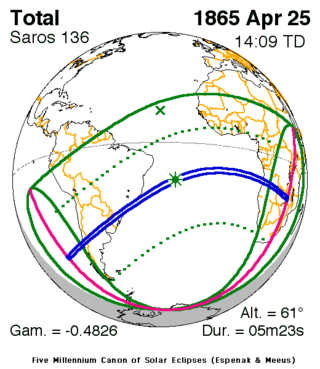| Solar eclipse of April 25, 1865 | |
|---|---|
| Type of eclipse | |
| Nature | Total |
| Gamma | −0.4826 |
| Magnitude | 1.0584 |
| Maximum eclipse | |
| Duration | 323 s (5 min 23 s) |
| Coordinates | 14°48′S 25°48′W / 14.8°S 25.8°W |
| Max. width of band | 219 km (136 mi) |
| Times (UTC) | |
| Greatest eclipse | 14:08:34 |
| References | |
| Saros | 136 (29 of 71) |
| Catalog # (SE5000) | 9199 |
A total solar eclipse occurred at the Moon's descending node of orbit on Tuesday, April 25, 1865, with a magnitude of 1.0584. A solar eclipse occurs when the Moon passes between Earth and the Sun, thereby totally or partly obscuring the image of the Sun for a viewer on Earth. A total solar eclipse occurs when the Moon's apparent diameter is larger than the Sun's, blocking all direct sunlight, turning day into darkness. Totality occurs in a narrow path across Earth's surface, with the partial solar eclipse visible over a surrounding region thousands of kilometres wide. Occurring about 1.2 days after perigee (on April 24, 1865, at 9:50 UTC), the Moon's apparent diameter was larger.[1]
The path of totality was visible from parts of modern-day Chile, Argentina, Uruguay, Brazil, Angola, Zambia, and extreme northwestern Mozambique. A partial solar eclipse was also visible for much of South America, Antarctica, and Africa.
- ^ "Moon Distances for London, United Kingdom, England". timeanddate. Retrieved 4 September 2024.
